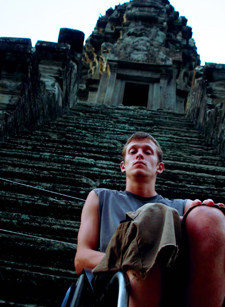
By Seth McBride
 Before a skiing accident left me with quadriplegia at the age of 17, I had never traveled out of North America. Not that I didn’t want to. The opportunity just hadn’t presented itself. In the 11 years since, I’ve traveled all over the world — to 14 countries on five continents.
Before a skiing accident left me with quadriplegia at the age of 17, I had never traveled out of North America. Not that I didn’t want to. The opportunity just hadn’t presented itself. In the 11 years since, I’ve traveled all over the world — to 14 countries on five continents.
There’s no doubt I’m infected with a certain amount of restlessness, but I suspect that everyone is to some extent. Most people are intrigued by the foreign. This is why we travel: to recapture some of the wonder we had as children, when the world still seemed a huge and marvelous place. Yet, invariably when I travel to exotic-sounding destinations like Laos, Cambodia or El Salvador, people question why I would to go to such “out of the way” places.
In the disability community the question is often related to accessibility: Why would I voluntarily travel to places where there are no ramps and curb cuts, where elevators are few and far between, where there’s no guarantee I’ll ever be able to fit into a bathroom? The simple answer is there’s a great big world out there and very little of it is accessible. Going only to those places designed for people with disabilities is extremely limiting.
Here, I think, a distinction needs to be made between travel and vacation. People vacation for fun and relaxation, to leave the stress of their everyday world behind. Vacation is a necessary enterprise, one I have to engage in from time to time, and I will throw no stones at those who choose to idle on a cruise or sip Mai Tais at a resort pool. Accessibility makes a vacation easier to enjoy.
But travel is a different thing. Travel can be dirty. It can be stressful, arduous, full of mental and physical effort. But for those willing to leave the shell of the comfortable and the familiar, travel can be rewarding beyond anything vacation has to offer.
One of the most beautiful days of travel I’ve had was sitting on the roof of a ferry in the blistering Cambodian sun. I had been piggybacked up there by one of my friends I was traveling with on a two-month tour of Southeast Asia. It was brutally hot and totally uncomfortable. But balancing on my wheelchair cushion with no backrest for five hours with no shade and very little breeze, I wouldn’t have wanted to be any other place in the world.
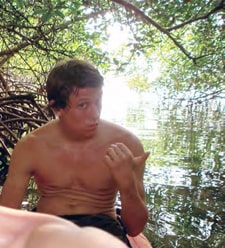 The boat traversed the flood plains that stretched from Battambang to Siem Reip, weaved through seemingly impenetrable thickets of marshland brush that forced us passengers to duck away from the boat sides to avoid being scoured by branches. When the maze opened to the vast waters of Tonle Sap Lake, the boat pushed slowly past floating villages — brightly colored houses floating on rafts tied to one another — as the residents plied the waters in long, wooden fishing boats to haul their living from the lake. It looked as if a person could live his whole life without ever touching dry land.
The boat traversed the flood plains that stretched from Battambang to Siem Reip, weaved through seemingly impenetrable thickets of marshland brush that forced us passengers to duck away from the boat sides to avoid being scoured by branches. When the maze opened to the vast waters of Tonle Sap Lake, the boat pushed slowly past floating villages — brightly colored houses floating on rafts tied to one another — as the residents plied the waters in long, wooden fishing boats to haul their living from the lake. It looked as if a person could live his whole life without ever touching dry land.
Here, in a fleeting glance of a world far from what I’d previously known, it might have been difficult and uncomfortable, but the experience never would have been possible if I’d stuck to accessible options.
First Trip Over the Pond
The first overseas trip I took was to visit my sister, who was studying in Amsterdam. Because it was a good deal cheaper to fly to London, I booked a flight with the plan of taking the train to Amsterdam. Admittedly, I was a bit naive — I hadn’t researched the trains or booked tickets, and I had no idea how I was going to get from Gatwick to the main Waterloo train station. Nevertheless, I got off the plane at Gatwick, asked about how to get to Waterloo, had a nice man unfold a ramp for me to get on a commuter train and soon found myself rolling through a hectic hub of British rail. I found the office for the Eurostar, the train that goes under the English channel to Brussels, Belgium and beyond, and booked a second-class ticket to Amsterdam.
I had just enough time to rush down to the train before it left, and when I arrived I was put up in a first-class seat because they didn’t have any accessible seats in the other cars. Some two hours after arriving in London with no idea how I was going to get to Amsterdam, I was sitting in a plush seat, rolling through the English countryside on a lovely spring morning, being served champagne with the first dish of my four-course meal.
When I switched trains for the Brussels to Amsterdam leg, there really were no accessible cars. So I was lifted up in between two cars (no ramp, no lift, just two guys and a less litigious society), and was soon joined by a friendly fellow who hopped on with no tickets and every possession he owned, and there we remained as the train clattered across the lowlands. Luckily I had a jacket to put on.
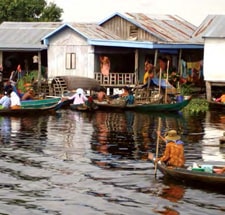 I would come to find out that in Europe such immediate changes in accessibility were common. New construction, be it buildings, facilities, or outdoor space, often had accessible design elements on par with what we’ve come to expect in the U.S. But in a continent with so much history, much of the construction predates a time when accessibility was even thought about. Often the spaces of most interest to a traveler, whether castles or cobbled city centers, were those hardest for me to get around.
I would come to find out that in Europe such immediate changes in accessibility were common. New construction, be it buildings, facilities, or outdoor space, often had accessible design elements on par with what we’ve come to expect in the U.S. But in a continent with so much history, much of the construction predates a time when accessibility was even thought about. Often the spaces of most interest to a traveler, whether castles or cobbled city centers, were those hardest for me to get around.
Southeast Asia, by contrast, proved much easier to navigate on a daily basis. Nearly all of the construction is new and low to the ground: very little of the exalted architecture of Europe and the stairs that accompany such design. Contrary to all expectations I had about Asia (crowded land mass equals crowded architecture equals cramped quarters and narrow doorways) the bathrooms of the region — from Bangkok to Batambang, Vientiene or Nha Trang — proved generally big enough to wheel into and do my business.
Having access to bathrooms is my primary worry when traveling anywhere. That’s why, as a low quad with good arm strength, I sit in a 14-inch wide manual chair with the wheels sucked in as tight as they’ll go. Hoisting myself up into a tuktuk, getting piggybacked from one boat to another or up the stone steps of a 12th century Cambodian temple can feel like an adventure. But there is nothing remotely enjoyable about rushing to find a toilet you can use before something bad happens.
Although the sidewalks may have been terrible (or nonexistent) and lack of ramps necessitated my accepting help and lifts far more often than I would have liked, having consistent access to bathrooms made all of the other hardships of traveling in Asia seem manageable.
El Salvador Stir-Fry
During my junior year of college I spent three months living in El Salvador, and it was often an adventure just pushing down the sidewalk. I was there teaching English and taking Spanish classes at a small language school in the capital of San Salvador. I found a relatively accessible place to live with only single steps that I could pull myself up just five or six blocks from the school.
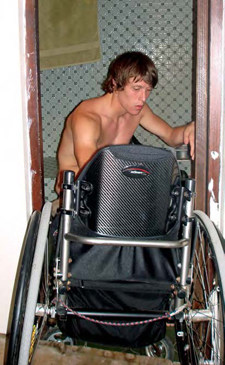
The sidewalks in San Salvador are wonderfully wide. Unfortunately, because they are so wide and there is no on-street parking, the sidewalks are turned into impromptu parking lots. Every morning the short route to school was filled with a different arrangement of obstacles: cars, motorcycles, trash, bicycles, and an occasional homeless man sleeping in their midst.
I had quickly become an expert at judging from a distance the spaces I could or couldn’t squeeze between, and if the distance between a car and the wall of a building were too tight, I would have to pop down the curb and make a brief foray into traffic before finding the nearest car-cut past the obstacle to get back on the sidewalk. Usually I would have to venture out into traffic four or more times on the typical six-block trek to school. After learning to expect it, getting narrowly passed by cars and buses was just another part of my daily routine.
One day, wheeling home from a movie theater, I felt the first droplets of afternoon rain coming down, turned the corner about five blocks from my house and saw a dark sheet of water racing towards me. I started sprinting towards home, but before I had made it one block, the squall caught me. In the minute or two it took me to make the final blocks home, I was saturated — like I had taken a shower fully clothed.
There was no washer/dryer in the house (or anywhere near), I’d washed all of my clothes in the morning and they were all hanging on the line undergoing a second rinse. I was supposed to go out and meet some friends from school in an hour or so and wasn’t looking forward to spending the rest of the evening in wet clothes.
Luckily I still had a clean pair of boxers and a dry T-shirt in my bedroom, so I changed into those. After looking around trying to think of a way to dry my pants in the next 30 minutes, I saw a large wok sitting by the stove. In a burst of inspiration I put my pants in the wok, set the stovetop to low and spent the next half an hour stir-frying my pants.
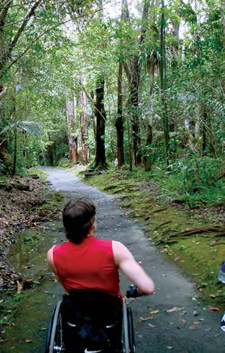 I flipped and stirred often so they wouldn’t burn, and watched the steam rise into the kitchen. By the time I needed to head out, the rain had passed and I had a warm, dry pair of pants, smelling only slightly of residual olive oil.
I flipped and stirred often so they wouldn’t burn, and watched the steam rise into the kitchen. By the time I needed to head out, the rain had passed and I had a warm, dry pair of pants, smelling only slightly of residual olive oil.
Learning to use a stove and a wok to dry my pants was but one of the countless ways I’ve had to relearn how to get through the day while traveling around the world. When I travel in countries that don’t have a culture of accessibility, even the most basic tasks, like wheeling down the street, going to eat and finding a bathroom, are suddenly foreign and deceptively difficult. But as soon as I learned to accept that things just weren’t going to be like they were back in the States, it became relatively simple to work around them.
In this way, I think, those who live with disabilities are peculiarly suited to learning to live or travel overseas. We already have plenty of experience with this kind of thing. After breaking my neck I was constantly forced to adapt and problem-solve to be able to get through my day with any measure of independence. In a few years I’d developed a routine and a relatively efficient way of going about my day and moving through my world.
Traveling abroad forces me to open my eyes and learn how to live all over again.
Support New MobilityWait! Before you wander off to other parts of the internet, please consider supporting New Mobility. For more than three decades, New Mobility has published groundbreaking content for active wheelchair users. We share practical advice from wheelchair users across the country, review life-changing technology and demand equity in healthcare, travel and all facets of life. But none of this is cheap, easy or profitable. Your support helps us give wheelchair users the resources to build a fulfilling life. |


Recent Comments
Bill on LapStacker Relaunches Wheelchair Carrying System
Phillip Gossett on Functional Fitness: How To Make Your Transfers Easier
Kevin Hoy on TiLite Releases Its First Carbon Fiber Wheelchair